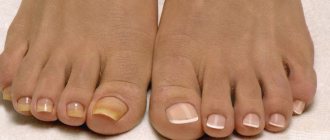What are moles? What are they?
To answer this question, you must first clarify what we mean by the word “mole.” An ordinary person can easily find several types of skin formations. Brown, red, flesh-colored - all these can be called moles. In fact, the World Health Organization (WHO) classification of benign skin lesions includes about 150 names. And all this diversity can also be called moles. Read a little more about the most common types of moles here.
As we said above, there are a huge number of types of moles. Today we will talk about those that are most common and, theoretically, can pose the greatest danger - brown and flesh-colored moles.
What can the doctor recommend?
Any changes in the color, shape, size and consistency of a mole require urgent consultation with a dermatologist. The doctor will rule out malignancy of the tumor and determine what exactly caused its transformation.
Frequent trauma to a nevus increases the risk of its malignancy, so experts recommend removing neoplasms located in open areas of the body. Are you looking for where to get mole removal in the Bratislavskaya metro area? Contact our clinic! We receive experienced specialists and have the necessary equipment to carry out such a procedure. Its cost can be seen in the price list on the website or specified by phone.
All articles
5% discount Print coupon from our website
Ask your question on the website Get professional advice!
Brown moles
Such moles are a cluster of nevus cells. These cells are very similar to melanocytes and, like them, produce the pigment melanin. This pigment is brown in color, which makes our skin darker if there is a lot of it and lighter if there is not enough of it. Its production also increases after prolonged exposure to the sun.
Melanocytes and nevus cells
Melanocytes and nevus cells have certain differences, which we will not delve into. Let’s just note that brown moles most often consist of nevus cells. It is nevus cells that can turn into melanoma cells - one of the most malignant human tumors (more about it here)
What can cause a mole to start growing?
There are several factors that can cause nevus cells to divide, i.e. mole cells.
The first factor is exposure to ultraviolet radiation
.
The fact is that the brown pigment melanin, which is produced by nevus cells, is designed to protect us from excessive exposure to ultraviolet radiation. The mechanism of this action is quite complex, but we need to emphasize that the more melanin in our skin, the less damaging the sun is. Thus, nevus cells begin to divide to produce more brown pigment and better protect us from ultraviolet radiation. Outwardly, this is manifested by the appearance of new moles and the growth of those that already exist.
The second known factor is pregnancy
.
During this difficult period in a woman’s life, the hormonal levels in the body change - a lot needs to be rebuilt and prepared for the birth of a child. We will not go into details about what hormones the body produces and in what quantities during pregnancy. Let us only note that they also influence the cells of the mole and very often cause them to divide and the mole to grow.
Third, fourth, fifth, etc. factors have a significantly smaller evidence base and I will simply list them separated by commas - puberty, therapy with anti-inflammatory hormones or growth hormone.
Clinical studies have shown that in about 16% of nevi, microscopic changes in structure can be detected within a very short time - from 2.5 to 4.5 months. This fact suggests that there are other reasons for the growth of nevi (moles), but unfortunately, their role has not yet been studied.
Why can mole removal be dangerous?
If you have already read about moles on the Internet, then you have probably already found information that “after removing moles, you can die from cancer.” I discuss this topic in detail in this article. Now I will say that such cases really do happen. This happens when a doctor removes a malignant tumor, which he considered an ordinary mole, and does not send it for histological examination. After this, indeed, melanoma can very quickly develop at the site of removal and this can cause death.
What do moles in the thigh area mean?
A good sign is a mole on the inside of the thigh in both women and men. Everything they take on works out and goes well. However, we are talking more about handicrafts - repairing, creating things. A man with this mark is a jack of all trades. The woman is a talented needlewoman.
The second quality of the owners of marks on the hips is isolation and introversion. Specifically in men, this is expressed in recluse, outsider, attachment to the mother, when the thigh of the right leg is marked. For women, this fate is predicted by a birthmark on the left thigh.
Meanwhile, the mark on the right thigh indicates an amorous, pleasant person. But on the left it reveals a somewhat cold nature in love. But, the predictions say, she is very hardworking and will never leave her family in poverty.
Interpretations of birthmarks on the legs reveal a lot of curious things. If any of them coincide or do not coincide, you should not put it first in the relationship. After all, the marks only warn. But man creates life himself.
Reasons for removing moles
In my opinion, there are 4 reasons to remove moles:
- The mole raises doubts about its benign quality among the oncologist. In this situation, we will not be talking about removing a mole, but about a biopsy of a possible malignant tumor. Subsequent histological examination will show whether a larger operation is needed or not.
- The mole is subject to regular trauma. This can happen when playing sports, shaving, during work, when a mole is located on the belt or bra line, as well as in a hairdresser. Regular traumatization of a mole, especially to the point of bleeding, may be one of the risk factors for the development of melanoma.
- A mole causes a cosmetic defect. No explanation needed here. The issue of beauty is very individual for each person and there are no clear rules here.
- A mole causes obsessive thoughts about its transformation into cancer or melanoma (oncophobia). As a rule, this happens after a long time of independently studying the Internet on the topic of melanoma and skin cancer. Sleep and appetite are disturbed, neurosis sets in, because if you want, you can find confirmation of anything on the Internet. Not only that “this mole I have is definitely melanoma,” but also that “Lenin is a mushroom.” In this situation, removal of the mole is necessary only to restore lost psychological comfort.
In the latter case, it is important to combine deletion with stopping independent study of the World Wide Web on the topic of skin cancer and melanoma.
Moles on the legs and ankles
The calves, shins and ankles are the area that reflects your purpose in life. If a mole is on the back of the lower leg, its owner is endowed with deep psychic abilities. Rich intuition, insightful mind. These people make good doctors, clergy, spiritual or life teachers.
When there is a nevus on the ankle on the right, there will be success where there is close communication with people. These are politics, journalism, sociology, psychology, social activities. The owners of such spots are eloquent and not devoid of positive religiosity. Their highest gift is the art of persuasion.
The left ankle, covered with moles, belongs to people with an active life as a traveler, field specialist. He has many contacts and connections, and he will always be received with joy. But unlike his previous relatives, he is loved not for his eloquence, which he does not particularly master, but for his rare ability to listen.
All other birthmarks on the calves, ankles, and knees indicate a person with hot energy inside and strong intuition. If such abilities have not been noticed until now, it is worth considering developing them. The results can change your entire life.
Summary or briefly about the main thing:
If your mole has enlarged, wait a minute to sound the alarm. First, answer the question: does the mole grow faster than 1-2 mm per year? If the rate is not higher than indicated and there are no other symptoms of melanoma (“geographical” edge, asymmetry along two axes, bleeding without injury, etc.), then most likely everything is fine with the mole. At the same time, if there is even the slightest doubt about the correctness of your conclusions, the oncologist should say the last word during an in-person examination.
If you still have questions, the following will help you:
- In-person appointment with an oncologist
(St. Petersburg) - Mole removal
with histology (St. Petersburg) - My online consultation (from anywhere in the world)
Transformation into a malignant tumor
Under certain conditions, moles can degenerate into malignant formations - melanoma. Such factors include ultraviolet radiation, trauma to the mole, and genetic characteristics. During degeneration, the appearance of the mole changes - it increases in size, becomes ugly, multi-colored. The condition of the formation can be assessed using dermatoscopy and visual examination by a dermatovenerologist or oncologist.
You should constantly monitor moles and see a dermatologist at least once a year. This is especially true for those whose relatives had malignant skin diseases.
How to distinguish malignant growth of a mole from normal one?
First: almost every mole on our body can grow at a rate of about 1-2 mm per year. In my opinion, such a rate of increase should not raise suspicions among the oncologist.
There are rare types of melanoma (lentigo melanoma) that can grow very slowly. More on them later. For now, I’ll just note that in most cases, this tumor grows quickly. Its increase often occurs at a rate of 1-2 cm over six months to a year.
Second: when answering the question “is it melanoma?” You always need to analyze the complex of symptoms. Rapid growth alone is rarely enough to cause serious suspicion. This is because lentigo melanoma can grow very slowly, sometimes over decades. At the same time, it will definitely reveal itself by the presence of other signs or during dermatoscopy. The benign nature of a mole will be confirmed by its smooth edge, symmetrical shape, hair on the surface, and its existence for 5 years or more. In favor of malignancy - “geographical” edge, asymmetry along two axes, bleeding without trauma, etc.
Dangerous symptoms of degeneration into melanoma
First of all, we note that blackening of the nevus is in itself an alarming symptom! Yes, sometimes the reason can be banal and harmless - friction on clothes, frequent exposure to the scorching rays of the sun. But this is still a sufficient reason to contact a specialist - a dermatologist or oncologist. This way you can stop the development of melanoma in time. Or reassure yourself that everything is fine with your health.
The mole has enlarged and darkened. What could this mean? If the blackening of the nevus is accompanied by other unclear symptoms, this is a reason to urgently consult a doctor! Let's present a list of the most common signs of malignancy:
- A sharp increase in size of the formation, a change in its shape and shade.
- Liquid, blood, and mucus are often released from the nevus.
- Hairs have appeared on the mole (if they did not grow there before).
- The nevus was surrounded by a white halo of discolored skin.
- Red, black, or other different colored spots appear on the mole.
- The surface of the nevus became rough, covered with roughness and cracks.
- The skin both at the site of the mark itself and around it has become denser.
- You feel unpleasant sensations in the location of the nevus - itching, pain.
If a mole has darkened or become convex, do not hesitate, consult an experienced doctor as soon as possible! Even one of the above symptoms is a sufficient reason for a visit.
What is a hanging nevus?
Let’s look separately at why the hanging mole has darkened. This is an ordinary harmless nevus, but located not in the thickness of the skin, but on the so-called stalk - attached to the epithelium with a small thin piece of tissue. A number of experts note that such moles are less likely than others to degenerate into dangerous melanoma. They are distinguished by their flesh color, somewhat rough surface and small size.
These formations cause discomfort to their owner because they are more susceptible to mechanical damage from clothing, hygiene items, jewelry, etc. than other nevi. Basically, they are located in “traumatic” locations - in the armpits, on the neck, in the intimate area.
Associated symptoms
Convex, hanging growths are equally susceptible to degeneration; hanging ones are often injured. The process of rebirth is accompanied by symptoms:
- Severe itching appears in the center of the mole and the area around it. Itches due to degeneration, due to the influence of external factors: insect bites, irritation from chemicals, food. When injured, the nevus can become inflamed and bleed.
- The hanging mole turns black, the old papilloma dries out and falls off. Dry old growths fall off on their own, leaving a pink mark, and a lump or new formation may appear. They dry out due to poor circulation and poor nutrition. The fallen piece should be taken for analysis to identify malignancy.
- It begins to peel off and become covered with a crust that can peel off.
- The flat growth begins to grow, change shape and structure.
- Pain appears.
- The growth or birthmark becomes hard to the touch.
- An inflammatory process accompanied by the appearance of small ulcers that emit an unpleasant odor and heal poorly.
- The skin around the formation swells, darkens or lightens, and redness appears.
Symptoms cause the development of a cancerous tumor.
Prices for removing nevi on the nose
Removal of nevi (moles), fibroids in adults and children over 12 years of age
| Delete area | Size | Price, rub |
| Initial appointment with a cosmetologist, consultation free of charge - subject to completion of procedures on the day of application Make an appointment | 1000 0 | |
| Removal on the nose Make an appointment | up to 1 cm. | 2 500 |
| Removal on the nose Make an appointment | more than 1 cm. | 3 000 |
First aid
When a mole falls off, it is necessary to prevent the development of complications even before seeking professional help. Manipulations depend on the type of mole damage.
- If a mole partially falls off.
To avoid infection of the wound, it is necessary to wipe it with hydrogen peroxide. This must be done immediately, especially if blood begins to ooze from it. After treating the wound, it is sealed with a plaster and the site of the injury is immediately shown to the doctor. - Complete falling away.
With this type of injury there may be some bleeding. First of all, it needs to be stopped. To do this, apply a sterile swab soaked in hydrogen peroxide to the damaged area. You need to keep it for at least half an hour, periodically changing it to a new one. Then a tampon soaked in an antiseptic is applied to the wound for 5 minutes. After all the manipulations, close the wound with a plaster and consult a doctor. It is necessary to get an appointment with a dermatologist in the next few hours, if possible. It is very good if the fallen mole or part of it is preserved. This will significantly improve the quality of diagnostic results and laboratory tests (for cancer cells). It is best to deliver the skin element to the laboratory in saline solution. If this is not available, a salt solution will do. It should not be highly concentrated, otherwise the results may be inaccurate. The nevus is placed in gauze soaked in liquid and submitted for testing in this form.











